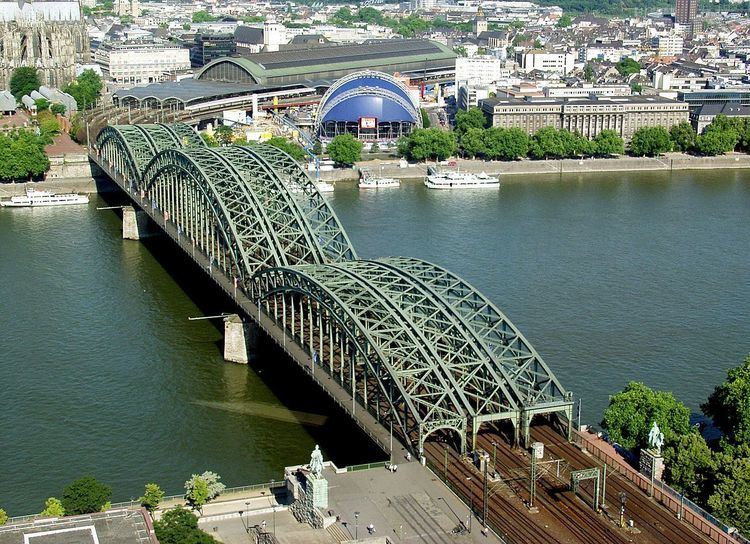Construction started 1946 Total length 409 m | Owner Deutsche Bundesbahn Opened 1911 Longest span 168 m Architect Franz Heinrich Schwechten | |
 | ||
Carries Train and pedestrian traffic Similar KölnTriangle, Cologne Cathedral, Imhoff‑Schokoladenmuseum, Romano‑Germanic Museum, Museum Ludwig | ||
A walk across hohenzollern bridge cologne germany 26th august 2013
The Hohenzollern Bridge (German: Hohenzollernbrücke) is a bridge crossing the river Rhine in the German city of Cologne (German Köln). It crosses the Rhine at kilometre 688.5. Originally, the bridge was both a railway and street bridge, however, after its destruction in 1945 and its subsequent reconstruction, it was only accessible to rail and pedestrian traffic.
Contents
- A walk across hohenzollern bridge cologne germany 26th august 2013
- Hohenzollern bridge
- History
- References
It is the most heavily used railway bridge in Germany with more than 1200 trains daily, connecting the Köln Hauptbahnhof and Köln Messe/Deutz stations.
Hohenzollern bridge
History
The bridge was constructed between 1907 and 1911 after the old bridge, the Cathedral Bridge (Dombrücke), was demolished. The Cathedral Bridge was unable to handle the increasing traffic in Cologne. The new bridge was named after the House of Hohenzollern.
The President of the Railway Directorate Cologne, Paul von Breitenbach started planning the construction and handed over this work to his successor Rudolf Schmidt in 1906. The project was headed by the railway engineer Fritz Beermann and under his direction the designs were worked out by Friedrich Dirksen. The construction of the Hohenzollern bridge took place from 1907 to 1911. Inauguration took place on May 22, 1911 by Kaiser Wilhelm II.
The bridge consisted of three adjacent bridge parts, each with three iron truss arches (passage openings) in the longitudinal direction to accommodate four railroad tracks and a road. Although the location of the bridge and the railway station were already controversial in previous structures, the Hohenzollern bridge took over the orientation of the previous bridge on the central axis of the cathedral.
Four equestrian statues of Prussian kings and German emperors of the Hohenzollern family flank each ramp. The Cathedral Bridge was already adorned with the statues of Friedrich Wilhelm IV of Prussia by sculptor Gustav Blaeser and Kaiser Wilhelm I by Friedrich Drake, which are now placed on the right bank of the Rhine (see pictures above). In addition sculptor Louis Tuaillon made the equestrian statues of Emperor Friedrich III and, during his lifetime, Wilhelm II, which were placed on the left bank of the Rhine (see pictures below). They depict the era of Prussian rule in the Rhine province.
The Hohenzollern Bridge was one of the most important bridges in Germany during World War II; even under consistent daily airstrikes the bridge was not badly damaged. On 6 March 1945, German military engineers blew up the bridge when Allied troops began their assault on Cologne.
After the war's end, the bridge was initially made usable on a makeshift basis but soon reconstruction began in earnest. By 8 May 1948, the Hohenzollern Bridge was accessible by pedestrians again.
The (southern) road traffic decks were removed so that the bridge now only consisted of six individual bridge decks, built partly in their old form. The surviving portals and bridge towers were not repaired and were demolished in 1958. In 1959, the reconstruction of the bridge was completed.
During the 1980s, the bridge was renovated with two new tracks. A very small portion of the old road ramp on the Deutz side was preserved, together with cobblestones and tram tracks. The rest was removed in connection with the construction of the Kölntriangle development and converted into a pedestrian and bike path.
The Hohenzollern Bridge now regularly has over 1200 trains pass through daily. The bridge is regarded as an important part of Cologne as it connects Cologne's central station with major European cities on the other side of the Rhine.
The total length of the Hohenzollern Bridge is 409.19 meters (1,342.5 ft).
Since 2008 people have placed love padlocks on the fence between the footpath and the railway lines. Dutch band Nits referenced this in their song "Love Locks" from their 2012 album Malpensa.
